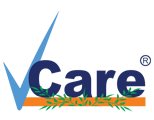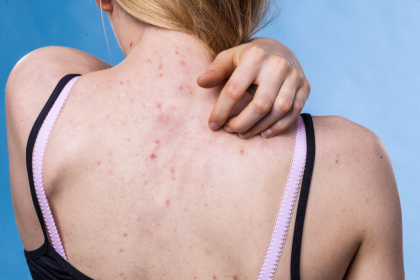
Published on January 26, 2023 | By Admin

We all come across different types of skin conditions very often due to various factors. One of them is the back acne which is common among adults but most often ignored without treating it properly. It is important to medically address the condition as there are high chances of any underlying conditions. This article will help you understand the causes, symptoms, and treatments for back acne.
Acne on the back is referred to as having pimples or cysts. It might entail:
Blackheads: The centre of each bump is a dark spot.
Whiteheads: The centre of each bump is white.
Papules: There is no identifiable “head” to each little lump.
Cysts: A severe form of acne, these itchy or painful masses resemble boils.
Although back acne is not a particular medical disease, it does present some particular difficulties in comparison to acne on the face. For instance, applying treatments to back acne may be more challenging to see and reach.
The back contains a high density of sebaceous glands, similar to the chest and face. Sebum, an oily substance that creates a protective layer for the skin, is produced by them.
Sebaceous glands are connected to pores or hair follicles. A blockage may result from sebum or dead skin cells clogging a pore. This obstruction could cause swelling or keep microorganisms in the pore. Lesions from acne form in this manner.
Malassezia, a form of yeast, can also produce lesions that resemble acne. In humid, sweaty settings, the yeast frequently overgrows. Clothing, backpacks, and slings frequently cover the back, making it a favourable environment for the development of this microorganism.
Pityrosporum folliculitis is a disorder that can develop if the yeast invades the hair follicles. Pityrosporum folliculitis could be the cause of back acne if antibacterial therapies have failed.
Many people are impacted by acne. Several elements that can encourage its development or increase the chance of it occurring include:
Acne affects teenagers frequently, presumably as a result of the rise in testosterone that occurs throughout puberty. In both males and females, testosterone is essential for preserving bone and muscle strength as well as encouraging the growth and development of the penis and testicles.
According to experts, testosterone increases the chance of clogged pores by causing the sebaceous glands to overproduce sebum. Having acne may become better as a person ages.
If one or both parents have acne, a person is more likely to get it themselves.
A person may be more susceptible to getting acne at a young age if both parents have it. A person may be more prone to have acne as an adult if both of their parents did.
According to a 2022 assessment of acne, men are more likely than women to acquire acne.
Other elements that could contribute to acne or bring on outbreaks include:
There is some evidence that dietary factors can either make acne worse or better. A low glycemic index diet has been demonstrated to lessen acne, according to a research. This entails staying away from harmful foods like bread, doughnuts, and potatoes, as well as eating “slow-burning” carbs that do not raise blood sugar levels.
Additionally, some research has linked cow’s milk consumption to greater occurrences of acne. There is no proof that other dairy products, such yoghurt or cheese, contribute to acne, so the connection is murky.
You might simply have acne on your upper back and shoulders. Or they could grow all over your back, torso, and waist. These zits may form in groups and might be uncomfortable. It’s possible for you to have more than one type of acne:
Back acne is typically easy to spot on your own. Consult your doctor if you have a lot of pimples on your back or if they continually reappearing. They will check your skin. If the issue is getting worse, they could advise visiting a dermatologist. However, there are other natural methods for treating acne in its early phases.
Most of the time, changing your lifestyle and employing at-home remedies will help you eliminate acne. Here are some methods for treating back acne:
After working out, letting sweat and debris stay on your skin can greatly increase your risk of developing back acne. After working out, take a shower as soon as you can. In between sweat sessions, you should wash those sweaty workout gear.
To remove excess debris and oils from your skin, use a light exfoliating scrub containing chemicals like salicylic acid. By doing this, the quantity of dead skin that could obstruct pores might be decreased.
Your exercise routine may aggravate back acne. For instance, wearing tight clothing might trap perspiration and debris, which will then push into your pores. Problems might also arise when exercising uncovered next to a sweaty gym machine or on a dirty floor.
Choose loose-fitting clothing that wicks sweat away from your body and lets your skin breathe.
The leaves of an Australian tree are used to make tea tree oil. Australians have long used it to treat a range of skin conditions. These days, the chemical is present in a wide variety of lotions, cleansers, and creams.
There is some evidence to support the idea that it could reduce acne-causing germs.
Your back’s skin may be getting oilier and dirtier from long hair, which can lead to breakouts of acne. Regularly wash your hair, and when working out, wear it up in a bun or ponytail.
Additionally, avoid letting shampoo or conditioner run down your back. These items’ ingredients may cause blocked pores.
It’s crucial to shield your skin from the sun’s harmful rays, especially if your back is exposed. But oily sunscreen can also cause pores to clog. Make sure to select products that are gentle on the skin and free of oil.
Have you ever heard the saying “you are what you eat”? Our bodies can be impacted by a poor diet in many different ways. Certain meals may be acne triggers if you are prone to the condition.
According to research, eating foods with a high glycemic index (GI), which causes your blood sugar to rise quickly, may aggravate acne. White breads, white pasta, white rice, and white potatoes are some examples of these items.
Adopting a diet that is balanced, healthful, and contains lots of:
Some people require a little more assistance to get rid of their acne. An oral medicine or medicated cream can be prescribed by a dermatologist if you’ve tried home cures but are still experiencing symptoms.
A dermatologist, a physician who focuses on skin diseases, can assist you in determining the origins and aggravating factors of your back acne.
In order to give our clients the finest outcomes possible, VCare committed and passionate practitioners have the luxury of hand-picking the goods, therapies, and treatment modes of services based on requirement.
The top-tier experts at VCare will assist you in identifying the underlying source of the problem, walk you through the best course of action, and produce the greatest outcomes.
Within a few days of the process, the Rapid Acne Clear System has been clinically shown to effectively reduce the size and redness of resistant acne. A specially formulated treatment cures the afflicted region, eliminates the bacteria that causes acne, and stops further breakouts. In a few steps, recreate fresh, smooth, and bright skin.
Although having back acne is completely normal, occasionally feeling anxious about your look may be caused due to that, and that’s also normal.
The change and fluctuation in hormone levels is one of the main contributors to body acne. Acne is a result of androgens like testosterone increasing sebum production, cell activity, and bacteria.
Your body acne might not always clear up on its own. After weeks of observing the above-mentioned steps, if your skin is still rough, it’s time to see a doctor. You might be instructed by your dermatologist to buy over-the-counter treatments containing salicylic acid or benzoyl peroxide.
Although cystic back acne can be treated, a person will often need a prescription for the drug, as well as guidance from a board-certified dermatologist. Even though some treatments take time to take effect, the skin should start to heal within six months. Early cystic acne treatment can lessen the risk of scarring.